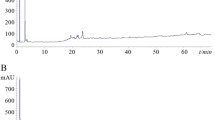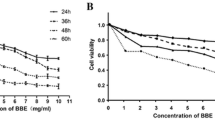Abstract
Objective
The apoptosis of Hela cells induced by ethyl acetate extract and n-butanol extract of Celastrus orbiculatus Thunb was studied in order to assess its antitumor effect.
Methods
Hela cells were cultured in vitro and treated by a series of concentrations of ethyl acetate extract and n-butanol extract of Celastrus orbiculatus Thunb. Cell proliferation was detected based on MTT assay. Quantity of apoptosis were observed and analyzed by flow cytometry with Annexin V and propidium iodide double staining. P53 gene expression was detected by flow cytometry.
Results
The proliferation of Hela cells was obviously inhibited by 15, 30, 60 and 120 μg/mL extract of Celastrus orbiculatus Thunb and apoptosis of Hela was induced by dosed dependent manner. P53 gene showed increasing tendency when treated by 60–480 μg/mL extract of Celastrus orbiculatus Thunb.
Conclusion
The ethyl acetate extract and n-butanol extract of Celastrus orbiculatus Thunb could induce apoptosis of Hela gastric cancer cells by dose dependent manner, which maybe one of the important mechanisms of Celastrus orbiculatus Thunb’s anticancer effects. P53 protein expression in Hela was up-regulated by Celastrus orbiculatus Thunb, which maybe one of the molecular mechanisms involved in the anticancer and proapoptotic effect of Celastrus orbiculatus Thunb.
Similar content being viewed by others
References
Zhang J, Xu YM, Wang WM, et al. Extract from the Celastrus experimental study of anti-tumor effects. Chin J Chin Mat Med (Chinese), 2006, 31: 1514–1516.
Zhang J, Xu YM, Liu YQ. Extract from the Celastrus effective study of inhibition in vitro. Pharmacol Clin Chin Mat Med (Chinese), 2006, 22: 99–101.
Yun XS, Bian RL, Chen X. Pharmacological Experiments Methodology. version 3. Beijing: People’s Medical Publishing House, 2002. 1785–1786.
Morkve O, Laerum OD. Flow cytometric measurement of p53 protein expression and DNA content in paraffin-embedded tissue from bronchial carcinoma. Cytometry, 1991, 12: 438–444.
Castedo M, Hirsch T, Susin SA, et al. Sequential acquisition of mitochondrial and plasma membrane alterations during early lymphocyte apoptosis. J Immunol, 1996, 157: 512–521.
Oren M. Relationship of p53 to the control of apoptotic cell death. Semin Cancer Biol, 1994, 5: 221–227.
Author information
Authors and Affiliations
Corresponding author
Additional information
Supported by a grant of State Administration of Traditional Special General Topics of Science and Technology (No. 04-05ZP35).
Rights and permissions
About this article
Cite this article
Wang, W., Liu, Y. & Dai, X. Apoptosis of Hela cell induced by Celastrus orbiculatus Thunb extract and primary mechanisms. Chin. -Ger. J. Clin. Oncol. 10, 666–668 (2011). https://doi.org/10.1007/s10330-011-0851-2
Received:
Revised:
Accepted:
Published:
Issue Date:
DOI: https://doi.org/10.1007/s10330-011-0851-2




